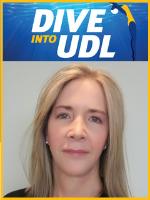
Event Information

Introduction - 10 minutes
We will hand out "fidgets" and materials to create "box breathing" square as participants enter. Relate their use to UDL and building a welcoming classroom environment.
We’ll then talk about the importance of building trust when we begin to explore and share executive function and goal setting. Brad will lead educators through a box breathing session (1 minute) and discuss how he uses these types of activities to the build the trust required to talk openly about executive function.
Introduction to UDL - 10 minutes
Kendra will introduce the updated Principles of UDL (3.0) - Why, What and How. And the newly included “Who” and how it relates to EF. We’ll briefly explore the concept of a "Hidden Curriculum" that includes executive function, metacognition and self-reflection, represented on the bottom "layer" of UDL.
Lesson - 30 minutes
Survey/Heat Map
We will share the Executive Function survey with participants created in Google Forms. Before participants complete, we will share our results (our strengths and needs) and then introduce the application of the survey results to a Heat Map.
Next, participants will complete an anonymous EF survey with 4 or 5 questions - planning, organization, sustaining interest, prioritizing, task completion - to keep the activity manageable. Note: We will provide them with a more detailed survey to use with their students.
Then, in small groups, participants will create a heat map (Google Slide) tracking their group’s results and discussing how they could use the heat map with their learners. For example, how would they use it...as an anonymous class map, with individuals, to plan group activities, or for targeted support?
We will bring the groups back together to share their thoughts and to further discuss how they would introduce EF and embed it into their instruction, goal setting, reflections, etc. to ensure the “hidden curriculum” remains visible.
Wrap up: Next Steps - Portfolio/Goal Setting (10 minutes)
To conclude the session, Brad will share portfolio website resources highlighting how he brought EF to the surface with his students. Highlights will include how he introduced EF to his students, how he (and his students) used Surveys and Heat Maps, how he embedded it in lessons and lessons and activities he developed to help improve and support various EF. He’ll conclude by sharing the student’s thoughts showing their growth over the year.
Note: Teachers will be given access to portfolio, goal setting activities, strategy lessons, etc.
Video - What is Executive Function and Why Does it Matter? https://www.edutopia.org/video/whats-executive-function-and-why-does-it-matter
Psychology Today - Executive Function
https://www.psychologytoday.com/us/basics/executive-function
UnderStood - What is Executive Function?
https://www.understood.org/en/articles/what-is-executive-function
Dive Into UDL - Second Edition (ISTE Publication) and related website www.diveintoudl.com

